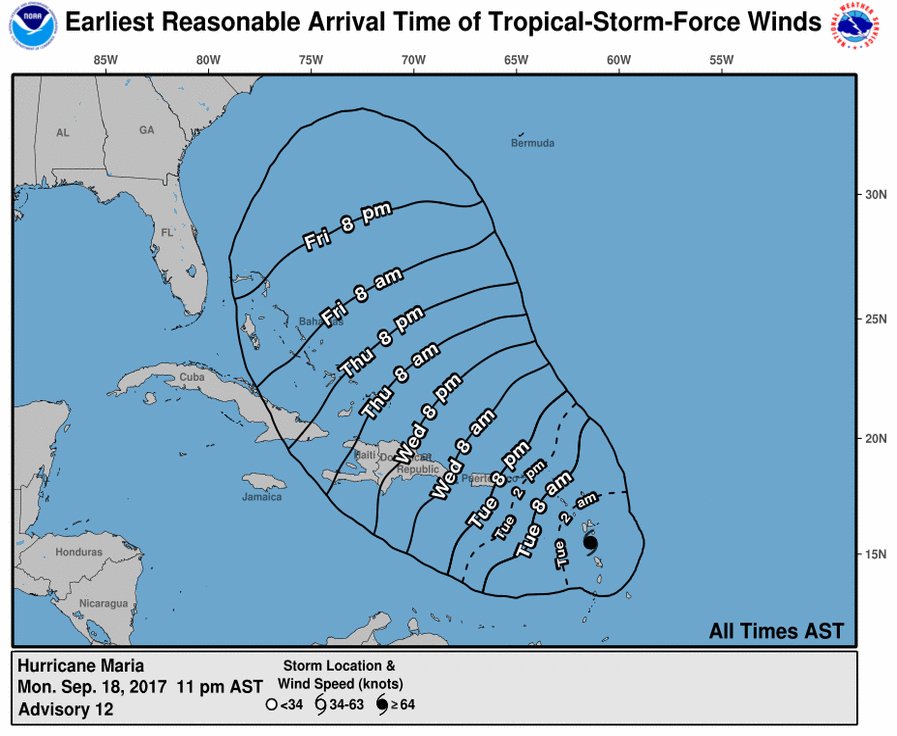Just a few weeks have passed since the Category 5 Hurricane Irma took on the Caribbean islands and southern Florida. Now, another powerful storm is hitting the Dominican Republic on Thursday after provoking massive damages in Puerto Rico and the little nation of Dominica, leaving devastation and misery.
Early this week, the Category 3 Hurricane Maria hit Puerto Rico – an island where 3.5m people live, officials have said. It destroyed so many areas in the territory; even experts estimated a few more months without any power.

Maria’s 115 mph winds regained strength on Wednesday night over the Caribbean open waters before the storm aimed at the Caicos Islands and the southeastern Bahamas – where it will arrive on Thursday evening. In the end, it may land on U.S. mainland.
It will be better for people who live in North Carolina’s Outer Banks to Cape Cod, Massachusetts, to stay alert for any new Maria forecast.
“Definitely Puerto Rico — when we can get outside — we will find our island destroyed,” the director of Puerto Rico’s emergency management agency, Abner Gómez, told reporters on Wednesday. “The information we have received is not encouraging. It’s a system that has destroyed everything it has had in its path.”
“The most devastating storm in a century,” told Ricardo Rosselló, Puerto Rico Governor
Things are rough for Puerto Rico after Maria struck the unincorporated U.S. territory. Its Governor expressed his concerns about the damages produced in the island’s electricity grid, which will take months to be repaired. Whit plenty of hope, Governor Rosselló said that God is with the Puerto Ricans, who are “stronger than any hurricane.” He is entirely sure that “together we will rise again.”
Around 10 people have died in the Caribbean due to Hurricane Maria. One of them was a citizen of Puerto Rico who was hit by a board he used to cover his windows. Officials advised people to move to higher places to avoid the “catastrophic” flooding and heavy rains. More of them are predicted on Saturday to reach highs of 30 inches (76cm).
U.S. President Donald Trump – who made federal emergency aid available – declared on Wednesday the island to be in a state “major disaster” after Puerto Rico’s Governor asked him to, according to a White House statement. Roselló ordered the people to stay in their houses – or somewhere safe – until Saturday, between 6 p.m. to 6 a.m.
Trump wrote Thursday that “we are with you (Governor Roselló) and the people of Puerto Rico.”
Maria is considered the most violent hurricane that has passed over Puerto Rico in 80 years. It also struck two other U.S. virgin islands that were already damaged by Irma: St. Thomas and St. Croix.
“Right now we’re in wait-and-see mode,” William “Brock” Long, administrator of the Federal Emergency Management Agency, told The Washington Post on Wednesday afternoon. “We know that St. Croix took a tremendous hit, and we know obviously Puerto Rico took the brunt of the storm. Once the weather clears and the seas die down, we’ll be in full operation.”
A possible Maria’s landfall in the U.S.
Experts can’t predict which ultimate path Maria is going to take due to the uncertain the weather forces are. The National Hurricane Center estimates it might make its landfall near to the U.S.

The Category 3 storm was influenced by Hurricane Jos – which is now near New England. Maria is aiming to the north, spinning in the corridor between Bermuda and the Atlantic seaboard.
The tracking models, according to CNN meteorologist Michael Guy, are good for knowing where and how Maria could move in the next three to five days. However, anything further is very uncertain. Guy did not assure the eye of the storm will take its way over the U.S, but he estimates that the East Coast will get affected anyhow.
“Most likely it will bring a chance of rain to the Mid-Atlantic up through Massachusetts depending on how close it gets to the coast… Regardless there will be high surf, dangerous rip currents and breezy, windy conditions up the East Coast of the U.S.,” Guy said. “Once we have a definitive forecast on where Maria will go after the next five days — then we can be sure if we are in the clear.”
Some forecasts show a reason to think that Maria is going to stay away from the United States: Jose, the Category 1 tropical cyclone currently off the Mid-Atlantic coast of the United States, which will maintain its trajectory for several days due to two high-pressure systems. However, Guy said that Maria might replace Jose, filling the space the Category 1 storm leaves between the two highs.
In the end, both Jose and Maria will produce rough surf and riptides from Melbourne up through Jacksonville.
Source: BBC
